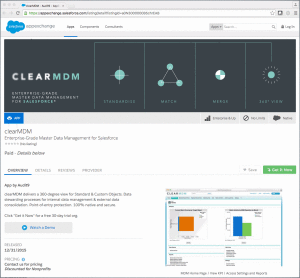For the first post on the clearMDM blog I feel it’s appropriate to provide an introduction for clearMDM that describes the primary intent behind the product. The term Master Data Management can mean many things in different contexts, in this post I hope to clarify the clearMDM perspective and why Master Data Management on the Salesforce platform makes great sense.
In Salesforce terms Master Data typically means Business Accounts (B2B), Person Accounts (B2C), Contacts, Leads or Products; but can also mean any non-transactional data held in either Standard or Custom Objects. This part I think is clear enough. The typical challenges encountered with master data relate directly to data quality and governance; in simple terms this means duplicated records, incomplete, non-standard or erroneous data or an absence of data management procedures and practices that support a continuous improvement cycle. The consequential business impact of such issues can be significant; operational inefficiency at point of service, sale or relationship management and an inability to execute effective marketing strategies based on segmentation rules that are aware of the full picture are just some examples of the issues that many businesses struggle to mitigate. The most common contributory factor, in my experience, is record duplication. Most companies employ multiple systems across the back-office to front-office lifecycle; ERP, Accounting, Ecommerce, Websites to name a few. Such systems require a proprietary view of the master records involved in transaction processing plus the ability to perform local master record maintenance. It is therefore the case that each system holds a subset of the organisation level master record data set and supports the ability to edit or extend this data silo autonomously. This works well at the system level as the model is unconstrained. At the organisation level requirements to segment customers or to deliver efficient service engagements using the collective business insight drawn from multiple systems requires a coherent master data management strategy.
The clearMDM product enables organisations to implement data management processes within their Salesforce CRM instance to address such challenges in a proactive, efficient manner using automation to minimise any manual overhead. Key objectives of the application are to enable a Single Customer View, through matching and merging duplicate records to deliver a clean set of master records, and the enrichment of master records through consolidation of information from external sources to deliver a clear 360-degree insight. The intent of the product is straightforward; to deliver a complete, lightweight master data management solution designed specifically to exploit the capabilities of the Salesforce platform that is maintainable by Salesforce Administrators. The clearMDM product ultimately enables data management to be a proactively governed administrative process not an operational business issue.
As an MDM vendor specialising in the Salesforce platform, and also an experienced CTA (Salesforce Certified Technical Architect), I’m often asked to qualify the suitability of Salesforce as a platform for MDM processing. For some the question reflects a perception of Salesforce as a CRM tool, for others the perception of MDM is that of a highly technical, complex and expensive software implementation delivered by projects running over many months or years. To the former point, Salesforce has evolved way beyond its CRM heritage to become the industry leading cloud platform-as-service (PaaS) play with powerful customisation potential, rich APIs and a mature eco-system. Software vendors of all types provide a wide range of enterprise level apps for the platform ranging from horizontal solutions such as accounting through to vertical solutions such as financial services, health and life sciences. In respect to the latter point, MDM products have historically taken a technical approach to resolving MDM challenges, with concepts, processes and tools aligned to an IT resourcing model. Such products typically introduce an additional data silo and a significant degree of data transmission overhead. Many organisations simply don’t need the level of capability offered, instead a light-weight, pragmatic approach makes more sense. Implementing MDM processing within Salesforce has the benefit of bringing data together directly at the point of use (service, marketing segmentation, consolidated reporting etc.) and typically extends existing data flows into the Salesforce environment rather than introduce an additional integration architecture. The points below provide a summary of the standard platform features that support the assertion that Salesforce provides a compelling platform for MDM.
- Schema definition; point-and-click design tools.
- Process automation; best-in-class workflow tools.
- Business rules; complex validation logic is a platform feature.
- Version management; field-history tracking and auditing.
- Secure and scalable; industry leading cloud platform.
- Granular access control; record-level and attribute-level visibility controls.
- Extensibility; powerful declarative tools augmented by code.
- Analytics; powerful built-in reports and dashboard features.
- Open platform; rich API support, mature eco-system.
- Mobile access; native device or browser-based apps.
Please feel free to get in touch via hello@clearmdm.com or @clearmdm with any questions regarding the clearMDM product or Master Data Management on the Salesforce platform.
Mark Cane
